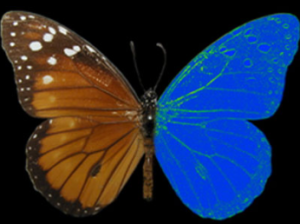Butterflies are among the most stunning creatures on Earth. Their wings look like living artwork—bright, symmetrical, and delicate. But this beauty sparks an interesting question: can butterflies see their wings? It might sound like a playful curiosity, but it leads us into a fascinating world of insect vision, survival strategies, and the limits of self-awareness. In this article, we’ll uncover the truth about butterfly eyesight, explore how they perceive color and movement, and explain whether they’re aware of their own dazzling wings.
How Do Butterflies See the World?

Butterflies don’t see the world like we do. Their eyes are uniquely adapted to help them survive in a world filled with motion, light, and color.
Compound Eyes: Nature’s Wide-Angle Lens
Butterflies have compound eyes made up of thousands of lenses called ommatidia. Each tiny lens captures part of the visual field, forming a mosaic-like image. It may not be sharp, but it allows butterflies to:
- Detect movement quickly
- See nearly 360 degrees around them
- Spot predators and nectar sources instantly
Butterflies and Ultraviolet Light
Unlike humans, butterflies can see ultraviolet (UV) light. Many flowers and even butterfly wings reflect UV patterns invisible to us. These help butterflies:
- Identify suitable flowers
- Recognize mates
- Navigate effectively
- This unique color perception is key to answering our main question.
Can Butterflies See Their Own Wings?
Let’s get straight to the point: Yes, butterflies can see parts of their wings—but not in the way you might think.
Partial Visibility, Not Self-Awareness
Due to their wide-angle vision, butterflies may catch glimpses of their own wing edges or tips during flight or rest. However, they don’t recognize their wings as belonging to themselves. There’s no self-awareness or understanding like humans have.
Why Their Vision Is Functional, Not Reflective
Butterfly vision evolved for survival, not self-appreciation. While they may notice motion or color from their wings, it’s processed more like a signal than a “mirror reflection.”
Why Are Butterfly Wings So Colorful If They Can’t Admire Them?
Wings aren’t just for flying—they’re tools of communication, camouflage, and protection.
Key Purposes of Wing Colors
- Mate Attraction: Patterns help identify species and mating readiness
- Camouflage: Some blend into their surroundings to avoid predators
- Warning Signals: Bright colors may signal toxicity (like monarch butterflies)
- Thermal Regulation: Dark wings absorb heat; light wings reflect it
Whether or not butterflies see their beauty, others—predators and mates—certainly do.
Do Butterflies Recognize Themselves?
- The Mirror Test:
What It Means The mirror test is used to evaluate self-recognition in animals. Creatures like dolphins, elephants, and magpies have passed it. Butterflies? Not so much.
- Lack of Cognitive Awareness :
Butterflies operate mostly through instinct and reaction. Their brains are small and specialized. There’s no evidence they possess the mental capacity for self-recognition or reflection
Conclusion:
Do Butterflies Know Their Own Beauty? So, can butterflies see their wings? Yes—to a certain extent. Their complex eyes allow them to catch brief glimpses of their wing tips and colors, especially during movement. But butterflies don’t “see” themselves in the way humans do. There’s no self-awareness, no reflection, no understanding. Yet despite this, butterflies continue to inspire us with their effortless beauty. They may not need to know they are beautiful—they simply are. And that’s enough for the rest of us to marvel at them. If nature can create something so vibrant and delicate without needing self-recognition, maybe that’s a reminder for us, too: you don’t need to see your own wings to fly beautifully.
